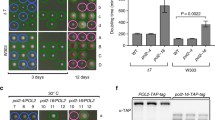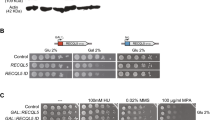Abstract
Ribonucleotide reductase (RNR) catalyzes the reduction of ribonucleotides to deoxyribonucleotides and thereby provides the precursors required for DNA synthesis and repair. In an attempt to test cell resistance to a permanent replicational stress, we constructed a mutant Saccharomyces cerevisiae strain containing exclusively nonrecyclable catalytic subunits of RNR that become inactivated following the reduction of one ribonucleoside diphosphate. In this rnr1C883A rnr3Δ mutant, the synthesis of each deoxyribonucleotide thus requires the production of one Rnr1C883A protein, which means that 26 million Rnr1C883A proteins (half the protein complement of a wild-type cell) have to be produced during each cell cycle. rnr1C883A rnr3Δ cells grow under constant replicational stress, as evidenced by the constitutive activation of the checkpoint effector Rad53, and their S phase is considerably extended compared to the wild type. rnr1C883A rnr3Δ mutants also display additional abnormalities such as a median cell volume increased by a factor of 8, and the presence of massive inclusion bodies. However, they exhibit a good plating efficiency and can be propagated indefinitely. rnr1C883A rnr3Δ cells, which can be used as a protein overexpression system, thus illustrate the robustness of S. cerevisiae to multiple physiological parameters.





Similar content being viewed by others
References
Binder M, Schanz M, Hartig A (1991) Vector-mediated overexpression of catalase A in the yeast Saccharomyces cerevisiae induces inclusion body formation. Eur J Cell Biol 54:305–312
Branzei D, Foiani M (2005) The DNA damage response during DNA replication. Curr Opin Cell Biol 17:568–575
Branzei D, Foiani M (2006) The Rad53 signal transduction pathway: replication fork stabilization, DNA repair, and adaptation. Exp Cell Res 312:2654–2659
Branzei D, Foiani M (2007) Interplay of replication checkpoints and repair proteins at stalled replication forks. DNA Repair (Amst) 6:994–1003
Camier S, Ma E, Leroy C, Pruvost A, Toledano M, Marsolier-Kergoat MC (2007) Visualization of ribonucleotide reductase catalytic oxidation establishes thioredoxins as its major reductants in yeast. Free Radic Biol Med 42:1008–1016
Cook M, Tyers M (2007) Size control goes global. Curr Opin Biotechnol 18:341–350
Cousens LS, Shuster JR, Gallegos C, Ku LL, Stempien MM, Urdea MS, Sanchez-Pescador R, Taylor A, Tekamp-Olson P (1987) High level expression of proinsulin in the yeast, Saccharomyces cerevisiae. Gene 61:265–275
Diffley JF (2004) Regulation of early events in chromosome replication. Curr Biol 14:R778–R786
Domkin V, Thelander L, Chabes A (2002) Yeast DNA damage-inducible Rnr3 has a very low catalytic activity strongly stimulated after the formation of a cross-talking Rnr1/Rnr3 complex. J Biol Chem 277:18574–18578
Ehrenberg A, Reichard P (1972) Electron spin resonance of the iron-containing protein B2 from ribonucleotide reductase. J Biol Chem 247:3485–3488
Eklund H, Uhlin U, Farnegardh M, Logan DT, Nordlund P (2001) Structure and function of the radical enzyme ribonucleotide reductase. Prog Biophys Mol Biol 77:177–268
Elledge SJ, Davis RW (1990) Two genes differentially regulated in the cell cycle and by DNA-damaging agents encode alternative regulatory subunits of ribonucleotide reductase. Genes Dev 4:740–751
Erhart E, Hollenberg CP (1983) The presence of a defective LEU2 gene on 2 mu DNA recombinant plasmids of Saccharomyces cerevisiae is responsible for curing and high copy number. J Bacteriol 156:625–635
Ghaemmaghami S, Huh WK, Bower K, Howson RW, Belle A, Dephoure N, O’Shea EK, Weissman JS (2003) Global analysis of protein expression in yeast. Nature 425:737–741
Gregory TR (2005) The C-value enigma in plants and animals: a review of parallels and an appeal for partnership. Ann Bot (Lond) 95:133–146
Gregory TR, Nicol JA, Tamm H, Kullman B, Kullman K, Leitch IJ, Murray BG, Kapraun DF, Greilhuber J, Bennett MD (2007) Eukaryotic genome size databases. Nucleic Acids Res 35:D332–D338
Hartwell LH, Mortimer RK, Culotti J, Culotti M (1973) Genetic Control of the Cell Division Cycle in Yeast: V. Genetic Analysis of cdc Mutants. Genetics 74:267–286
Hartwell LH, Culotti J, Pringle JR, Reid BJ (1974) Genetic control of the cell division cycle in yeast. Science 183:46–51
Jorgensen P, Tyers M (2004) How cells coordinate growth and division. Curr Biol 14:R1014–R1027
Jorgensen P, Nishikawa JL, Breitkreutz BJ, Tyers M (2002) Systematic identification of pathways that couple cell growth and division in yeast. Science 297:395–400
Kolberg M, Strand KR, Graff P, Andersson KK (2004) Structure, function, and mechanism of ribonucleotide reductases. Biochim Biophys Acta 1699:1–34
Lengronne A, Pasero P, Bensimon A, Schwob E (2001) Monitoring S phase progression globally and locally using BrdU incorporation in TK(+) yeast strains. Nucleic Acids Res 29:1433–1442
Leroy C, Mann C, Marsolier MC (2001) Silent repair accounts for cell cycle specificity in the signaling of oxidative DNA lesions. EMBO J 20:2896–2906
Lindahl T (1993) Instability and decay of the primary structure of DNA. Nature 362:709–715
Longhese MP, Clerici M, Lucchini G (2003) The S-phase checkpoint and its regulation in Saccharomyces cerevisiae. Mutat Res 532:41–58
Lynch M (2006) Streamlining and simplification of microbial genome architecture. Annu Rev Microbiol 60:327–349
Mao SS, Johnston MI, Bollinger JM, Stubbe J (1989) Mechanism-based inhibition of a mutant Escherichia coli ribonucleotide reductase (cysteine-225—serine) by its substrate CDP. Proc Natl Acad Sci USA 86:1485–1489
Mao SS, Holler TP, Yu GX, Bollinger JM, Jr., Booker S, Johnston MI, Stubbe J (1992) A model for the role of multiple cysteine residues involved in ribonucleotide reduction: amazing and still confusing. Biochemistry 31:9733–9743
Marsolier MC, Roussel P, Leroy C, Mann C (2000) Involvement of the PP2C-like phosphatase Ptc2p in the DNA checkpoint pathways of Saccharomyces cerevisiae. Genetics 154:1523–1532
Mirkin EV, Mirkin SM (2007) Replication fork stalling at natural impediments. Microbiol Mol Biol Rev 71:13–35
Mumberg D, Muller R, Funk M (1994) Regulatable promoters of Saccharomyces cerevisiae: comparison of transcriptional activity and their use for heterologous expression. Nucleic Acids Res 22:5767–5768
Nasmyth K (1999) Control of S Phase. In: DePamphilis ML (ed) Concepts in Eukaryotic DNA Replication. Cold Spring Harbor Laboratory Press, Cold Spring Harbor, pp 331–386
Ni J, Verbavatz JM, Rippe A, Boisde I, Moulin P, Rippe B, Verkman AS, Devuyst O (2006) Aquaporin-1 plays an essential role in water permeability and ultrafiltration during peritoneal dialysis. Kidney Int 69:1518–1525
Osborn AJ, Elledge SJ, Zou L (2002) Checking on the fork: the DNA-replication stress-response pathway. Trends Cell Biol 12:509–516
Pellicioli A, Lucca C, Liberi G, Marini F, Lopes M, Plevani P, Romano A, Di Fiore PP, Foiani M (1999) Activation of Rad53 kinase in response to DNA damage and its effect in modulating phosphorylation of the lagging strand DNA polymerase. EMBO J 18:6561–6572
Sherman F (1991) Getting started with yeast. Methods Enzymol 194:3–21
Shimada K, Pasero P, Gasser SM (2002) ORC and the intra-S-phase checkpoint: a threshold regulates Rad53p activation in S phase. Genes Dev 16:3236–3252
Sikorski RS, Hieter P (1989) A system of shuttle vectors and yeast host strains designed for efficient manipulation of DNA in Saccharomyces cerevisiae. Genetics 122:19–27
Tercero JA, Longhese MP, Diffley JF (2003) A central role for DNA replication forks in checkpoint activation and response. Mol Cell 11:1323–1336
Tourriere H, Pasero P (2007) Maintenance of fork integrity at damaged DNA and natural pause sites. DNA Repair (Amst) 6:900–913
van Gaal EV, Spierenburg G, Hennink WE, Crommelin DJ, Mastrobattista E (2010) Flow cytometry for rapid size determination and sorting of nucleic acid containing nanoparticles in biological fluids. J Control Release 141:328–338
Vernis L, Piskur J, Diffley JF (2003) Reconstitution of an efficient thymidine salvage pathway in Saccharomyces cerevisiae. Nucleic Acids Res 31:e120
Viggiani CJ, Aparicio OM (2006) New vectors for simplified construction of BrdU-Incorporating strains of Saccharomyces cerevisiae. Yeast 23:1045–1051
Wach A, Brachat A, Alberti-Segui C, Rebischung C, Philippsen P (1997) Heterologous HIS3 marker and GFP reporter modules for PCR-targeting in Saccharomyces cerevisiae. Yeast 13:1065–1075
Wagner A (2005) Energy constraints on the evolution of gene expression. Mol Biol Evol 22:1365–1374
Yabuki N, Terashima H, Kitada K (2002) Mapping of early firing origins on a replication profile of budding yeast. Genes Cells 7:781–789
Young KD (2006) The selective value of bacterial shape. Microbiol Mol Biol Rev 70:660–703
Zhang J, Schneider C, Ottmers L, Rodriguez R, Day A, Markwardt J, Schneider BL (2002) Genomic scale mutant hunt identifies cell size homeostasis genes in S. cerevisiae. Curr Biol 12:1992–2001
Acknowledgments
We thank Jean Daraspe for expert technical assistance in electron microscopy, Jean-Yves Thuret for support in video-microscopy, Jean-Louis Sikorav for insightful comments, Sylvie Camier for discussions on RNR at the outset of this work, Etienne Schwob and Christelle de Renty for discussions on BrdU incorporation and detection and Sophie Chéruel for discussions on RNR constructs. This study was partly financed by grants from the Association pour la Recherche sur le Cancer (ARC) and from the Agence Nationale de la Recherche (ANR).
Author information
Authors and Affiliations
Corresponding author
Additional information
Communicated by A. Aguilera.
Electronic supplementary material
Below is the link to the electronic supplementary material.
Rights and permissions
About this article
Cite this article
Ma, E., Goldar, A., Verbavatz, JM. et al. Giant yeast cells with nonrecyclable ribonucleotide reductase. Mol Genet Genomics 285, 415–425 (2011). https://doi.org/10.1007/s00438-011-0613-4
Received:
Accepted:
Published:
Issue Date:
DOI: https://doi.org/10.1007/s00438-011-0613-4




